by Zygmunt Stojowski [1]
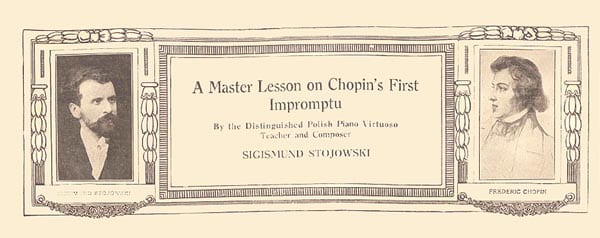
Chopin’s Quality
Chopin! These two syllables breathe a magic spell. Whoever has laid his hands on a piano, nay, whoever has listened to a piano, whether it be in a concert hall or to escape the encompassing fetters on the wings of melody, forever remembers and wishes to revert to the web of enchantment in which that magician held him. To analyze the subtle charm, to translate into words the radiance and fragrance, the storm and stress, the alternating grace and depth, the flights and depressions, the ever-changing but eloquent moods of that music, which vibrates like a human heart laid bare, would seem as impossible as to pull down a star from the moon-lit skies or catch a cloud swiftly wandering across space, vaporous yet shining, or thunder-laden.
An eminent Polish writer, Przybyszewski, rightly calls Chopin’s musical power “meta-musical.”[2] Chopin seemingly reverts to and transports the listener back to that primitive age, when tone and word almost inarticulate and as yet inseparable, were the direct outburst, the one cry of overwhelming human emotion. Since the common birth of man’s winged twins, evolution has not only separated music and language, but coiled up both into signs and symbols, terms and forms, differentiated and definite, till they became trivial and meaningless, soiled by common use. It is the privilege of high art, of romantic art in particular, if the term be taken in its emotional and imaginative sense, to create in man the illusion of Paradise Lost. This the art of Chopin achieves through the use of an idiom as novel and original as it is tasteful and refined; of a form where purity almost classical combines with richness unprecedented; through the fusion of spiritual loftiness and sensuous beauty never achieved before nor since at the piano; a blending of the music’s message with the instrument’s resources, such that Rubinstein well could say: “It was impossible to know whether the master had imparted his soul to the piano or himself embodied the piano’s soul.”
Chopin Colorist, Poet and Innovator
Chopin’s piano style is more than idiomatic, if it be true that an instrument be something more than the outward projection, an aggrandizement of a human organ, as the camera is an unconsciously conceived but faithful reproduction of the eye. The piano has become with Chopin the necessary magnified human organ for an adequate expression of rich inner life, the speaking voice of a poet, the many-hued palette of a painter; hence his limitation to the instrument of his choice was as necessary and voluntary as it was unique in the history of musical art.
A supreme master of tone color and an innovator in that respect, Chopin was, indeed, as much as Wagner, with whom Mr. Finck advisably compares him.[3] Each of the two worked out the same miracle in his own sphere and with his own particular means: Wagner, in the music drama, in the splendors of his orchestra, Chopin, in the more intimate but not less unique and powerful tone-poems of a “piano bard” and “piano rhapsodist.” Besides the coloristic capacities of instrumental setting, harmony is the most efficient element of expressive tone-color. So it happened that Chopin and Wagner respectively, as they had widened the range of piano technique and orchestral resources, also achieved the most marvelous framework of opulent and startlingly novel harmonic texture. This has become, indeed, the very foundation of the modern harmonic idiom.More subjective at heart than Wagner, who tied objectively to illustrate the action on the stage, Chopin, lyric poet of the piano, yet was stirred by externals to more or less realistically romantic attempts at portrayal. Some of his pieces seem almost symphonic poems for the piano, to which his letters sometimes give an interesting cue. He did not think fit to burden them with explanatory titles, still less with literary programs; but it is easy in some cases to discern the epic vein in the light of some generating poems or circumstances we happen to know about.
Poland’s Drama in Chopin’s Music
He never wrote an opera, as was suggested to him; but of dramatic intensity his work is full to the brim. The drama of a noble soul, imprisoned in a frail and worn body, of a soul that mirrored the aspirations of a race which was living then, as it is now, the most heartrending of dramas, would necessarily bring forth accents of deep and tragic pathos. Chopin, himself, claimed that his music embodied the soul of his beloved nation; indeed, like Mickiewicz, Poland’s greatest poet, he could say: “I am a million, because for millions I love and suffer.”[4]One need not indulge in what Mr. Ernest Newman calls “race fallacy” to perceive and discern in Chopin’s utterances, impassioned and moody, almost simultaneously sad and joyous, now dipped in the melancholy of our landscapes, now sounding the chivalrous pride and nobility of bygone days or the mournful echoes of dire times—the manifold and compelling chords with which the mysterious harp of the Polish soul is strung.[5]
There are two ways of being national open to an artist: one, in the conscious use of characteristic peculiarities and of folk-lore; the other, through the mysterious and revelatory connection between the individual heat and the collective soul. “Memories of ant-natal dreams, combined with the memories of his young days, carried away from the native soil and its people and music, in those years of the soul’s apprenticeship when it is most durably impressed, have made Chopin national in both senses. In an address delivered at Chopin’s centennial in Lemberg, Mr. Paderewski has in nobly eloquent words explained why and how the entire Polish nation responds and vibrates to the music of Chopin, in which it unfailingly recognizes its very own features.[6] The so-called tempo rubato, itself, universally identified with Chopin’s style, could be termed a trait of our national life. Musically it is a craving for liberty; it is a rebellion against the artificial tyranny of bar-line and rhythmic regularity and constraint, “as if it were the yoke of some hated government.”
The Real Chopin and the World’s Judgments
Pole, pianist, poet, these three words sum up the quintessence of Chopin’s personality, as well as any formula ever made. In these three fundamental aspects he was deeply subjective and revolutionary. Schumann said with the unerring insight of a kindred spirit: “Chopin’s works are cannons buried in flowers” “A tone poet.” Heine, his contemporary and friend, already called him. Of the pianist Mendelssohn said he performed marvels “which no one would ever have believed possible.” But the world, those critics whom Schumann accuses of always lagging behind, ever was and still is apt to misunderstand an opposed boldness and delicacy alike. The piano is much maligned and belittle and Chopin suffers from that bias. Although his message reached the world outside of Poland by its force and humanity, few are broad-minded as Dr. Bie, who candidly confesses: “Why should a German’s feeling be better or saner than a Pole?”[7]The human intellect eager to understand, but too prone to judge in its attempts to weigh the material, to measure the immeasurable, especially in this scientific age of ours, so conceited about its precisions and estimates, is apt to go astray in its pretenses to analytical and perfect justice. Prose alas, is ever ready to oppose poetry; hence the queer, disparaging talk about a genius like Chopin, against which Mr. Fink vehemently but righteously protest. The emotional nature of Chopin’s inspiration, the very abundance and spontaneity of an improvisatory, creative genius, the racial versatility of his high-strung nature, sufficiently explains his preference for smaller forms, which has been construed into “child-like helplessness” in the larger ones. The marmorean coldness of the sonata could scarcely appeal to him in this diffused rigidity. If it be true that form is but extended rhythm[8]and such rhythm be chiefly an intellectual element in music, the incompatibility of this tyranny with this nature is here illustrated in the same way as it is by his rubato. But this write holds that some of Chopin’s innovations in this field were most happy, and if some forms did not “master him,” he nevertheless perfectly mastered such forms as suited the needs and contest of his message.[9]
Chopin the Titan
As for the absurd legend of a “sickly,” “effeminate” Chopin, it implies both a tribute to the feminine side of his genius—for creative artists are apt to be double sexed—and a strange blindness as to the fact that the author of the Polonaises and Scherzi, Ballades and Sonatas, the Fantasie, Etudes, and Barcarolle, was a Titan as well as a magician. The body struggled to the end against unforgiving illness, but inside a flame burned unflinchingly. The muse of the sick man in turns voiced the tenderness and glory of life, forebodings of death, even serene visions of the Beyond. On his very death-bed Chopin dictated music. I know of no higher achievement of manliness. Another achievement of man and artist alike was that Chopin worked and struggled hard—a solitary soul among the worldly crowd in which he moved—to overcome his improvisatory impulse, as if it were a deficiency, ever correcting and perfecting his conceptions with pitiless self-criticism and undaunted courage, before he could satisfy the aristocrat in soul and utterance he really was. The revelations of George Sand make of this a pathetic story. Mr. Huneker calls Chopin an “unconscious classic.” If the very essence of art be choice, if only those who most deliberately sift and choose are apt to become classics, then the “greater Chopin” surely was a classical though what we know of his efforts toward perfection would not make him an unconscious one. Unconscious, he only was in the divine part of inspiration that was his. But some would have us believe that there are higher and nobler ideals than his! Morals are indeed the “Circe of philosophers,” as Nietsche says, and musical critics do not escape the temptation in their efforts for a class-room hierarchy of genius. As if art could have a nobler purpose than sincerity of heart allied to beauty of expression! This alliance is enough indeed to satisfy the legitimate human pride in artistic effort, to raise art above any other form of human play.
Mr. Stojowski’s Analytical Lesson on the Impromptu in A flat
Here is a lovely and lovable instance of noble “play” as conceived by a genuine artist’s fancy. Limpid, vaporous supremely graceful in design, crystal-like in its clarity of structure, it scarcely suggests the deeper aspects of the “greater Chopin.” It does not sound the “pathological” (?), or simply pathetic key-note, does not reflect the Polish soil or reveal the Polish soul. It is not one of those exotic products for the perfect understanding and rendition of which the insight and enthusiasm of racial affinity would seem necessary. “Nor is it either the perverse” and “objectionable” (!) Chopin with the complex psychology of his maturity, such as one would shrink from putting into young hands. Yet it is Chopin, young Chopin, too, but so true and complete, that Schumann could exclaim about it: “Chopin will soon be unable to write anything without making people cry out that it is by him.” At the same time, Schumann, the generous, noble-spirited and only rival, stated with equal truthfulness that “that Impromptu so little resembles anything in the whole circle of his works that it cannot be compared with any other Chopin composition.”
Dedicated to Mademoiselle la Comtesse de Lobau, published in 1837 and bearing the opus number 29, this “Impromptu”—his first—has not been commented upon by Chopin himself, as has been the second, evidently dearer to his heart as it also is deeper in tone and more artful in form.[10]
In none of Chopin’s Impromptus does the character of the piece wholly correspond, to my mind, to the definition of the name, given in Grove’s dictionary as that of an ex-tempore composition. Schubert’s Impromptus have more “naïveté”—as Mr. Huneker rightly contends—but even in those we meet with clear-cut forms and in one instance with a charming set of cleverly worked-out variations, hardly ever with free trend of extemporaneous thought. Spontaneous as Chopin’s first Impromptu appears in conception, its perfect—though simple—structure scarcely suggests improvisation. The puzzle of titles in music, whether generically conventional or aiming at mysterious associations, ever remains a puzzle. Definiteness of word and elusiveness of sound can only be ill-mated. But the French say: “Qu’importe la fiole, pourvu qu’on ait l’ivresse”—What does the bottle matter if one only has the ecstasy!
Formal Structure
Two conceptions, contrasted in character and treatment, have supplied the material and form of this Impromptu, which—like a minuet—consists of three parts, the third being a repetition of the first, the main subject thus enclosing the middle-section. These parts are in turn divided into sections, the first in three (A,B,C); the second or middle part into two (D,E).[11] It is to be noted that while C carries a reminder—not as would be usual a repetition—of A, out of which is evolved an extension and climax, the two segments of the middle section (D, E) are quite distinct and lead straight on to the return of the beginning. This breaks the regularity of a conventional pattern in a happy way, distinctive of Chopin’s resourcefulness in avoiding rigidity and monotony.
The First Part: Character and Interpretation
Prof. Niecks, sometimes badly deficient in his characterizations of the more recondite aspects of Chopin’s masterpieces, but obviously enamored with this gentle piece, aptly compares the first part, with its ever moving triplets, to the bubbling and sparkling of a fountain “on which the sunbeams that steal through the interstices of the overhanging foliage are playing.” The melodic lines are skillfully wrapped up—”enclosed in charming figurations,” as Schumann says. Their waves freely and swiftly rise and fall, the performer’s expression has to follow the fancifully described curves with velvety fingers in naturally graded upward crescendos and downward diminuendos. The greater the length of the ascending wave, the greater must be the crescendo which once even rises to a powerful climax (11) [12] when the melodic top-notes can be markedly brought out in their shifting, syncopated rhythm (see Figure 2).

Some repetitions of bars and harmonic sequences offer instructive examples of coloristic possibilities in treatment. As this writer ahs previously insisted upon, repetition—and the kindred term of sequence, which is repetition on another degree of the scale—can either mean increased intensity of mere echoing. In each case the general character and context of the music should guide the performer’s taste. Even if the composer’s precise and authoritative directions should leave him no choice, these ought to be carried out intelligently. The duplication of the first bar may be played piano, without the [crescendo sign] indicated (1) [in m. 1]. But when that repetition recurs at (2) [in m. 6] —it seems opportune to enforce it, at is leads into the dominant-key with a crescendo towards the top note. Again the repetition of bar (5) [in m. 14] lends itself to an echo-like treatment, and the removal of pedal would seem advisable in view of the purpose. Chopin’s disparaging remark about Thalberg that he played “forte and piano with the pedals, not with his hands,” need not be taken too literally and would only affect misuse turned into mannerism. The conclusion at which a commentator has jumped, that “the pedals should of course only be employed with a view to the quality and not the quantity of tone desired,”[13] strikes indeed beyond the mark. Tone-quality at the piano is a largely quantitative affair and the damper-pedal is an important dynamic as well as coloristic factor, the importance of which has surely been fully recognized by Chopin, in whose music the use of the pedals, in every way, is of paramount importance.[14]The treatment of the beautiful sequences equally requires a capricious diversity, partly subject to individual taste, for instance: the reproduction in part B of the melodic device (4) [in m. 11] can be effectively diminished instead of augmented toward a piano B-flat on top. The sustained quarter notes in this section require, of course, a singing quality (3) [in m. 8].There is yet another way of shading repetitions and sequences. The chromatic chords at (6) [in m. 15], which lead to section C, the editor suggests starting piano, coloring by a crescendo in the middle sequence (7) [in m. 16] followed by a diminuendo in the last sequence (8) [in m. 17]. In the same way can be treated the harmonic repetitions before the close of section C (10) [in m. 27], where it seems as if the wavering sunbeams were ever hesitating on the surface of the waters, broken up into a myriad of glittering pearls. The editor suggests a crescendo with slight hastening toward the middle, followed by a gradual diminuendo effect and slackening of tempo to melt finally into the pianissimo top note F (11) [in m. 30, see Figure 1 above; and Figure 3).
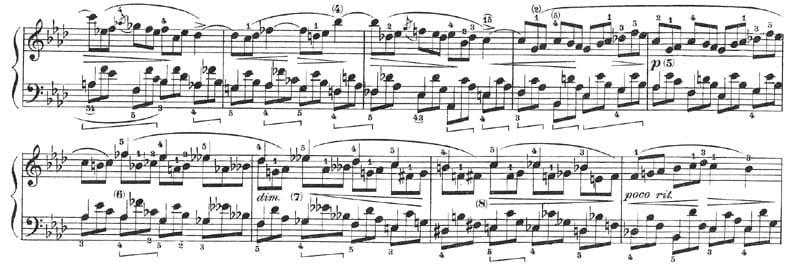
Some of Chopin’s most characteristic ways appear in the harmonic web, in the rich chromatics by which Chopin vivified—also sensualized—the austere German diatonic harmony of yore. Also what Dr. Bie calls Chopin’s “Driestimmigkeit”—a persistent sense of three superposed, freely flowing, rather harmonic than contrapuntal parts, constantly underlies the structure, imparting to it a peculiar wealth of euphony. This an adequate of the pedal should enhance without excessive fear of ornamental passing notes, but with due respect to the purity of line. The indicated sustaining of quarter notes in the chromatic sequences in treble and bass, also the slight, occasional overholding of melodic notes as indicated (10) [in m. 27], serves to emphasize this peculiar kind of polyphony.
The Middle Section
In the middle section a voice seems to rise from the depths of the playing waters. The change of the everflowing triplets into a broad rhythm and the shifting of tonality to the relative minor key adds to the contrasting value of a cantilena, which now as distinctly dominates the whole fabric as previously the melody had been concealed in figuration. It breathes nobility, tenderness, yearning; in its second section even rises to passion. The noble melody is apt to please German critics. It has what they so highly prize and call “Langathmigkeit,” a long breath. Compared to the pregnantly short Beethovenian themes, or to the mostly fragmentary melodies of Schumann, Chopin’s melody has indeed the longest swing and scope. Before Wagner, Chopin is the inventor of the “unendliche Melodie”—unending melody—but the melody under consideration differs from the Wagnerian mode in as much as it is an articulate phrase, consisting of two distinct sections, themselves sub-divided according to the regular patterns of phrase building.
The broad and noble initial bars of section D appear twice, leading through passing modulations to a cadence in the key of C major, reached in a roundabout enharmonic way, of truly Chopinesque character in its boldness and novelty. The haze of melancholy that seemed to veil the singing voice as it arose toward the sun is now dissolved in soft light (14) [in m. 48]. The “fiorituras” which call upon our attention are a most characteristic feature of Chopin’s style, derived both from the ornaments of the old master, the so-called “agreements,” and from the contemporary vocalises of the Italian opera; but they are distinctly Chopinesque, in as much as he has absolutely humanized their artificiality. “The dainty little notes which suddenly descend on the melody like a spray of dewdrops glistening in all the colors of the rainbow” are in fact an integral part of the melody, and should be treated in consequence without haste, with perfect repose and dignity. The holding back of the tempo is not only permissible in such cases, but necessary; and rhythmical divisions then may be read into the seemingly irregular and puzzlingly capricious arabesques (see Figure 4).
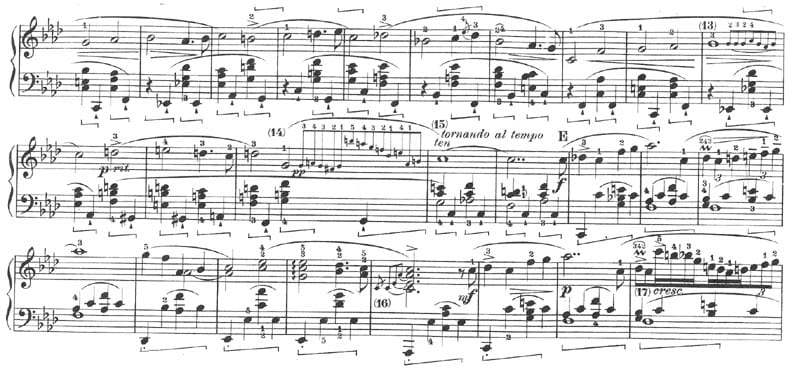
Thus, the editor would suggest playing the bar with ornament (13) [in m. 45] in the following manner:

(This without conspicuously retarding, only insisting somewhat upon the pathetic repetition of the B flat.) In the group of small notes at (14) [in m. 48] the holding back of tempo actually implies holds upon the last two quarternotes of the bar and the division may be accomplished thus:
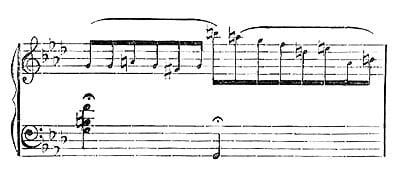
Other irregular runs may be divided as suggested in the test (17,19) [17 – in m. 61; 19 – in m. 71]. The first of the grace-notes preceding a trill (18,21) [18 – in m. 62; 21 – in m. 78]—or a chord (16,20,22) [16 – in m. 58; 20 – in m. 74; 21 – in m. 78]—should be struck with the bass-chord.After two transitional bars of harmonic filling (15) [in m. 49], the tonic C turn into the fundamental dominant of the second phrase of the F minor section (E, see Figure 4 above). This episode consists of two main repetitions including that of the modulation to the relative major key; but a noteworthy feature of it is that various figurations are employed to enhance and enrich the several repetitions of the design of the initial bar. The differentiation in the shadings of these repetitions has been indicated by the editor according to his best understanding, which may be found somewhat different from other editions. Chopin’s works have reached us in most casually corrected original editions, and the later ones have brought into the field a considerable amount of confusion, until one often feels the need of revising in turn what has been revised seemingly in an authoritative but not necessarily convincing manner.
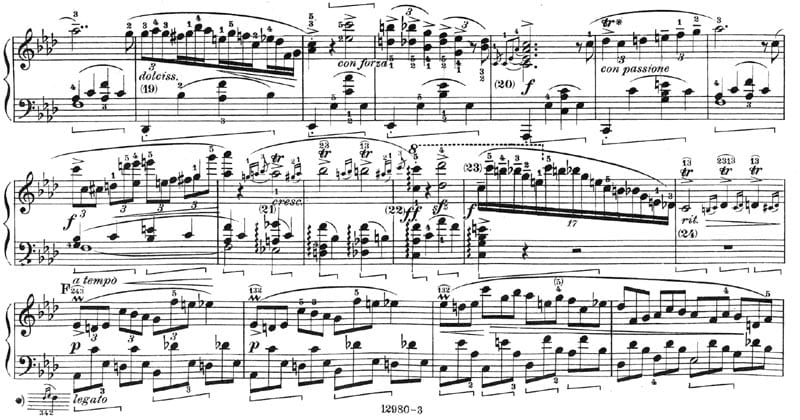
The cadenza which concludes this part again calls for free but comprehensive treatment (23) [in m. 81]. Bülow rightly suggests that the first notes be held back “pathetically” before the run dashes downward; also that the value of the following trills be prolonged almost the double (24) [in m. 82]. The first note of each trill should be marked by an accent, and a gradual diminuendo must precede and prepare the return of the first subject in its own lighter vein and graceful shape. It is interesting to note that the bridgings-over between the two sections are both homophonic, and that while in the first the tonic descends by a stop to the tonic in the bass (12) [in m. 34], in the second, the dominant chromatically moves up to the dominant in the treble (24) [in m. 82; see Figure 7).The repetition of the first part (F) [from m. 83] brings no new element, except a short extension in the coda (G) [from m. 113] through the interpolation of some chords (25) [in m. 115] between the repetitions of the closing section. These, by a sort of gradual elimination, waveringly, falteringly interspersed with silences, bring to an end the play of the bubbling fountain, as if large drops were falling slower and slower from the receding waters, until the whole vision vanished and fades away into dreamland, whence it came. The “sotto-voce” indicated by the composer (25) is thus explained-partly explained away—as one of those general directions applying to the spirit but not to the letter—the particular point where used. It is to be gradually reached through the shadings suggested. A syncopated pedal—the foot coming down after the chord having been struck—and a complete removal of the pedal during the rests, will greatly enhance the mysterious, waning effect desired. Figure 8).

Notes
[1]. This and all subsequent notes by Maja Trochimczyk. Original publication data: A Master Lesson on Chopin’s First Impromptu, By the Distinguished Polish Piano Virtuoso, Teacher and Composer Sigismund Stojowski (Philadelphia: Theodore Presser Co., 1915). This performance study of Chopin’s Impromptu in A-flat Major, Op. 29, was published in the series, Master Lessons on the Works of the Great Composers for the Pianoforte (Philadelphia: Theodore Presser Co.), including up to that point five other Stojowski editions (Rubinstein’s Barcarolle, Op. 30, No. 1; Schubert’s Moment Musical, Op. 94 No. 3; Schumann’s Nachtstuck, Op. 23 No. 4; Schubert-Liszt’s Hark! Hark! The Lark); and one piece each by Mendelssohn (Rondo Capriccioso) and Mozart (Fantasia in D Minor). [Back]
[2]. Stojowski refers here to Stanisław Przybyszewski’s (1868-1927) first study of Chopin, in Zur Psychologie des Individuums (Berlin, Fontane & co., 1892-1906). Przybyszewski’s philosophy of creativity was expressed in idiosyncratic studies of Chopin, Nietzsche, and Ola Hansson. [Back]
[3]. Henry T. Finck (1854-1926), Chopin and other Musical Essays (New York, Scribner’s, 1889). Reprinted in 1892, 1894, 1904, 1910. [Back]
[4]. Quotation from “The Great Improvisation” spoken by Konrad, the main protagonist in a romantic drama, Dziady [The Forefather’s Eve], written by Adam Mickiewcz (1798-1855) in 1832, after the fall of the November Uprising of 1831. [Back]
[5]. Ernest Newman (1868-1959, real name: Robert Williams), was the most famous English music critic in the first half of the 20th century. His books included studies of Gluck, Wagner, Elgar, Hugo Wolf, Richard Strauss, Beethoven, Mozart, Thomas, Verdi, Puccini, and Liszt. He was particularly interested in the opera. The source of the reference to “racial fallacy” is not known. [Back]
[6]. Ignacy Jan Paderewski, “Chopin, mowa” in Obchód setnej rocznicy urodzin Chopina i pierwszy Zjazd Muzyków Polskich we Lwowie (Lwów, 1912), 195-202. Published in English as Chopin: A Discourse trans. Laurence Alma-Tadema (London: Addlington, 1911). Reprinted in Polish Music Journal 4 no. 2 (winter 2001). [Back]
[7]. Dr. Bie, probably Oskar Bie (1864-1938), the author of A History of the Pianoforte and Pianoforte Players, trans. Ernest E. Kellett, and Edward W. Naylor (London, 1899), reprinted New York: Da Capo Press, 1966). Bie was a prolific writer on music, the author of: Intime Musik ([Berlin] Bard Marquardt et co., 1904); Reise um die Kunst (Berlin, E. Reiss, 1910); Tanzmusik (Berlin: Bard, Marquardt, 1905). [Back]
[8]. Stojowski’s note: “Jules Combarieu: La Musique, ses lois et son evolution.” Jules Combarieu, (1859-1916), La musique, ses lois, son évolution (Paris: E. Flammarion, 1907). English trans. as Music, its Laws and Evolution (London, K. Paul, Trench, Trübner & Co. Ltd., 1910). [Back]
[9]. Stojowski’s note: “I am glad to pay a tribute on this occasion to the illuminating book of Mr. E. Stillman Kelley, which deals with that side of Chopin’s genius and to American critics such as Mr. Huneker and Mr. Finck, who have showed an insight and understanding of Chopin’s art which it is perhaps permissible for a Polish artist gratefully to commend.” Edgar Stillman Kelley (1857-1944), Chopin the Composer; His Structural Art and its Influence on Contemporaneous Music (New York, London: G. Schirmer, 1913). [Back]
[10]. Stojowski’s note: “A Polish letter of Chopin, comparatively recently published an to which I do not remember any reference made in any foreign book or essay, bears out the assertion about Chopin’s occasional descriptive tendencies, as it relates, almost down to details, the genesis and context of the F-sharp major Impromptu.” [Back]
[11]. Stojowski refers here to letters inserted in his edition of the score. A—m. 1; B—the middle of m. 8; C—m. 19; D—m. 35; E—m. last eightnote in m. 50. Additional letters appear in m. 83 (F) and m. 113 (G). [Back]
[12]. The numbers in brackets have been inserted into Stojowski’s edition to indicate points of interest that he mentions in the text. However, number 11 appearing here is wrong: the climax in the first part of the work occurs on Stojowski’s No. 9 (in m. 23). Stojowski’s numbers appear in the following measures: (1) in m. 2; (2) in m. 6; (3) in m. 8 just after the letter B; (4) on the last quarternote (B-flat) in m. 11; (5) in m. 14; (6) on second quarternote in m. 15; (7) on second quarternote in m. 16; (8) on second quarternote in m. 17; (9) in m. 23; (10) in m. 27; (11) in m. 30, on the pianissimo eightnote before the fermata; (12) in m. 34, on the last note of the descending passage; (13) on the first note in m. 45; (14) on the second half-note in m. 48; (15) in m. 49; (16) in m. 58; (17) in m. 61; (18) in the middle of m. 62; (19) in m. 71; (20) in m. 74; (21) on the trill in m. 78; (22) in m. 80; (23) in m. 81; (24) in m. 82. [Back]
[13]. Stojowski’s note: “G.C. Ashton Johnson: A Handbook to Chopin’s Works. A most valuable book of reference.” George Charles Ashton Jonson (1861-?), A Handbook to Chopin’s Works (New York, Doubleday, 1905). [Back]
[14]. Stojowski’s views on the use of the pedal are similar to those of Paderewski. See Paderewski’s texts on rubato and Chopin in The Polish Music Journal 4 no. 1 and 2 (2001). [Back]